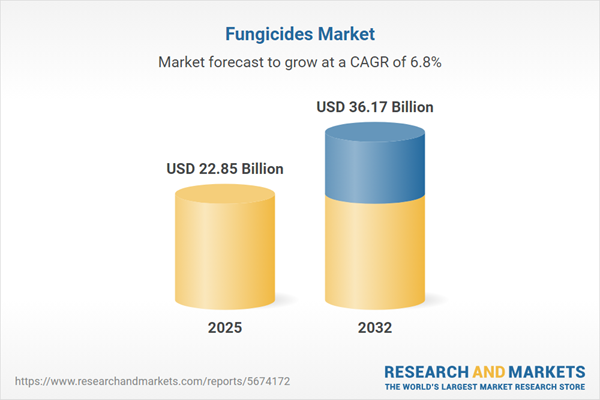Speak directly to the analyst to clarify any post sales queries you may have.
The fungicides market is evolving rapidly as agricultural producers confront mounting pathogen resistance, sustainability demands, and shifting regulatory landscapes. This report delivers a comprehensive view for senior leaders seeking to align strategy and operations with these sector-wide changes.
Market Snapshot: Fungicides Market Size and Growth Outlook
The fungicides market grew from USD 21.42 billion in 2024 to USD 22.85 billion in 2025. It is expected to continue growing at a compound annual growth rate (CAGR) of 6.76%, reaching USD 36.17 billion by 2032.
Comprehensive Scope & Segmentation
This report provides strategic segmentation to guide executive decisions and support robust market planning across product development, procurement, and investment. Key segmentation includes:
- Type: Biofungicides, Contact fungicides, Systemic fungicides
- Crop: Cereals & vegetables, Fruits & vegetables, Oilseeds & pulses
- Formulation: Emulsifiable concentrate, Suspension concentrate, Water-dispersible granule, Wettable powder
- Application: Foliar spray, Post-harvest, Seed treatment
- Mode of Action: Multi-site inhibitors (chloronitriles, dithiocarbamates), Single-site inhibitors (strobilurins, triazoles)
- Technology: Bio-based agents (botanicals, microbials), Conventional formulations
- Application Method: Aerial, Ground
- Sales Channel: Direct, Distributors, Online
- Regions: Americas (including North America, Latin America), Europe, Middle East & Africa, Asia-Pacific (with detailed country coverage)
- Companies: Syngenta AG, Bayer AG, BASF SE, Corteva Agriscience, FMC Corporation, UPL Limited, Sumitomo Chemical, Adama Agricultural Solutions, Nufarm, Nichino
Key Takeaways: Fungicides Market Strategic Insights
- Biotechnological advancements and the adoption of bio-based fungicides are accelerating innovation pipelines, reducing environmental impacts, and enabling next-generation crop protection solutions.
- Digital agriculture and data-driven monitoring platforms are redefining precision in fungicide application, optimizing resource use, and driving operational efficiency.
- Globally, regulatory changes are reshaping product approval cycles, emphasizing residue management, and creating incentives for microbial and botanical control agents.
- Strategic collaborations between leading industry players, regional specialists, and technology providers support fast-tracked product development and broaden market access.
- Distinct regional market dynamics require tailored approaches to product positioning, distribution network formation, and compliance management across Americas, EMEA, and Asia-Pacific.
Tariff Impact: Navigating 2025 US Tariffs and Supply Chain Shifts
Recent United States tariff developments are reshaping the global fungicide supply chain. Increased tariffs on imported fungicide intermediates and finished goods are prompting manufacturers to diversify sourcing strategies and explore local manufacturing options. Downstream, distributors and major agricultural operations are adapting procurement and inventory strategies, emphasizing cost control and supply reliability. Agility in responding to changing trade conditions will be essential for maintaining competitive positioning in end markets.
Methodology & Data Sources
This report employs a rigorous methodology combining primary interviews with agronomists, growers, distributors, and regulatory officials, alongside secondary research from industry filings, patents, and peer-reviewed literature. Field evaluations and quantitative analyses validate findings to ensure accuracy for executive decision-making.
Why This Report Matters
- Provides actionable intelligence for investment, procurement, and R&D planning as the global fungicides sector transitions towards sustainability and advanced technology.
- Enables granular segmentation and regional insight for precise product positioning and channel strategies.
- Supports trade and supply chain optimization, guiding risk mitigation under changing global regulatory and tariff frameworks.
Conclusion
This report equips industry leaders with the necessary insights and tools to navigate the evolving fungicides market, respond to regulatory and technology shifts, and drive enduring business outcomes.
Additional Product Information:
- Purchase of this report includes 1 year online access with quarterly updates.
- This report can be updated on request. Please contact our Customer Experience team using the Ask a Question widget on our website.
Table of Contents
3. Executive Summary
4. Market Overview
7. Cumulative Impact of Artificial Intelligence 2025
Companies Mentioned
The companies profiled in this Fungicides market report include:- Syngenta AG
- Bayer AG
- BASF SE
- Corteva Agriscience, Inc.
- FMC Corporation
- UPL Limited
- Sumitomo Chemical Co., Ltd.
- Adama Agricultural Solutions Ltd.
- Nufarm Limited
- Nichino Co., Ltd.
Table Information
| Report Attribute | Details |
|---|---|
| No. of Pages | 187 |
| Published | October 2025 |
| Forecast Period | 2025 - 2032 |
| Estimated Market Value ( USD | $ 22.85 Billion |
| Forecasted Market Value ( USD | $ 36.17 Billion |
| Compound Annual Growth Rate | 6.7% |
| Regions Covered | Global |
| No. of Companies Mentioned | 11 |









